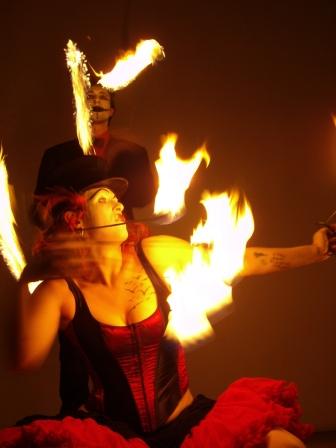“Infiammato” at Bedlam: More Heat than Light
Lightsey Darst attended a fiery show on a cold night. Its not exactly her religion, but heyit might be yours. Through March 31.

“Infiammato—an incendiary opera!” Bedlam Theater’s website promises. The press image shows a woman in a bright red corset, dramatically lit, with fire swirling around her. Hmm, that’s interesting! I think as I pause in my search for something to see. Opera, bedlam, corsets, fire—all this suits my current mood, and sounds like a good break from the deadly serious high art I’ve been mired in lately. I’m expecting, hoping for something like a circus—loud, breathless, frightening, and magical.
But I’m sorry to report that Infiammiato (the creation of Rah Kojis) is, well, not good. It’s poorly lit, the performers do not project to the audience, the music is mostly undistinguished throbbing stringed-instrument sawing (and not loud enough), the fire tricks seem labored and moth-eaten, the story (such as it is) lurches ahead in a series of scenes each more or less like the ones before. By the two-thirds mark, the show felt like an act of supreme cheek—to keep all these people out in the cold (yes, it’s an outdoor show), sitting still, for an hour and a half, for this! A mistake’s been made, I thought, burying my frozen fingers under my thigh. Someone’s marketing an amateur performance as if it were professional.
But then, I realize, Infiammato is not exactly meant to be merely a piece of theater. It’s billed as a spring equinox celebration—the Heart of the Beast May Day’s demented cousin, maybe. So perhaps Infiamatto should be compared to other rituals rather than to other stage performances. In that light, I have to say that Infiamatto is more lively than most of the Methodist services I’ve witnessed, though not nearly as clear. I’ve seen only one Catholic mass, in French, at Notre Dame: like Infiamatto, it was badly lit, and the priests didn’t project to the audience. The Catholic mass scored pretty low marks on intelligibility, too, as it was in French. But then, lackluster as the performance was, there was the building—moody, ancient, ascending straight to god—and that was enough. What does Infiammato have?
Inspiration. The last time I encountered the fire dancers who make up most of the performers here, someone told me they had their own religion. Whether it’s true or not, it makes sense. They do look entranced when balls of fire go whirling past their faces. And, as religions go, you could do worse than be fascinated with fire: mystical, essential, dangerous, fire is a power, an element, a force. I came closest to being involved in this piece through fire—not through the tricks so much, but through the simple evocation of various forms of flame. And fire makes particular sense this time of year: it’s the color, the feeling we’ve been missing all winter, the fervor we’re eager to welcome back into our lives.
Community. Take the scene before the show: bedlam at Bedlam, people milling around without order, the show sold out, everyone talking. An accordion and musical saw duo play in a large open room, the saw like some old woman’s haunting nasal voice, while a little girl, wearing no shirt and jeans that are slightly too big for her, runs around and around on the wood floor, shrieking as a slightly older boy makes fake dives at catching her. Her mother, swathed in multiple layers of unfamiliar-looking garments, looks on. Later, outside, people yell encouragement to the performers. A good number actually stand up beyond Bedlam’s fence to watch the show. The end of the performance seems to be the beginning of a party; no one’s going home.
This is not a community I’m part of, I should make clear: I was very happy to get back to my warm Volvo and my classical music at the end of the evening. Nor do I find it a particularly welcoming community; their standards are exacting. These are the people who don’t shop at the Wedge because it’s too corporate, preferring the “real” co-op. These are the tall bike riders, the Hard Times Café regulars. Even if I didn’t find it welcoming, though, I saw that others did. In this light, the wretched experience of sitting for an hour and a half in the cold is transformed. Groups like to undergo mild torment together; it’s a bonding experience, and the heart of many rituals. So if you go, make sure you bring your community with you (and possibly a blanket). Beyond the granola/punk contingent, I did spot one other community—not involved in the production, but showing up in good numbers—the African immigrant community of Cedar-Riverside.
A few stars. One Methodist church in Tallahassee had a star preacher. His delivery was as individual as Jimmy Stewart’s; his sermons were like fruity drinks, easy-going froth with a little sucker-punch of religion. Like all stars, he was distracting; he didn’t make you think about Jesus much. In Infiammato, Daniel Polnau’s Balinese-inspired shadow puppets are the distracting stars. A flurry of these intricate puppets cross a large screen at the beginning of the show—scraggly fish, a mother-goddess crone with a full belly, an eerie skull with long stiff hair, a neck trailing off into a sperm-tail, and two blank eye-holes visible only if the skull turns around. What story do these archetypal shadows tell? I wanted more.
Saira Huff and Melanie Ree’s costumes also stood out: painted transparent cloth over petticoat frames made Weird Sisters out of the women on stilts; elsewhere, vivid colors, wonderfully tacky fabrics, and laced details stood out (or would have stood out had they been better lit). Huff and Ree designed for a baroque burlesque, sexy and mysterious, that never comes to life on stage.
As a performance, I can’t recommend Infiammato. As a ritual—if you want one—you could do worse.